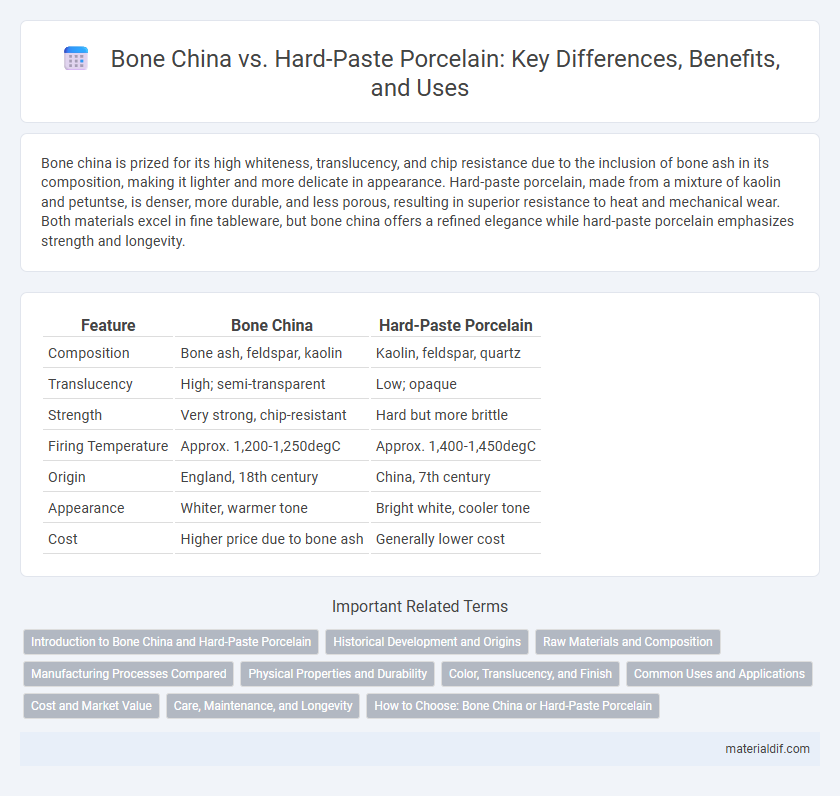Bone china is prized for its high whiteness, translucency, and chip resistance due to the inclusion of bone ash in its composition, making it lighter and more delicate in appearance. Hard-paste porcelain, made from a mixture of kaolin and petuntse, is denser, more durable, and less porous, resulting in superior resistance to heat and mechanical wear. Both materials excel in fine tableware, but bone china offers a refined elegance while hard-paste porcelain emphasizes strength and longevity.
Table of Comparison
| Feature | Bone China | Hard-Paste Porcelain |
|---|---|---|
| Composition | Bone ash, feldspar, kaolin | Kaolin, feldspar, quartz |
| Translucency | High; semi-transparent | Low; opaque |
| Strength | Very strong, chip-resistant | Hard but more brittle |
| Firing Temperature | Approx. 1,200-1,250degC | Approx. 1,400-1,450degC |
| Origin | England, 18th century | China, 7th century |
| Appearance | Whiter, warmer tone | Bright white, cooler tone |
| Cost | Higher price due to bone ash | Generally lower cost |
Introduction to Bone China and Hard-Paste Porcelain
Bone china is a type of porcelain known for its high levels of whiteness, translucency, and strength, achieved by adding bone ash to the traditional porcelain mixture. Hard-paste porcelain, originating from China, consists primarily of kaolin and petuntse, resulting in a dense, vitrified body fired at higher temperatures. Both materials offer unique durability and aesthetic qualities highly valued in fine tableware and decorative ceramics.
Historical Development and Origins
Bone China originated in 18th-century England, combining bone ash with porcelain clay to enhance translucency and strength, making it prized for fine tableware. Hard-paste porcelain, developed earlier in 7th-century China during the Tang Dynasty, uses kaolin and petuntse, forming a dense, durable ceramic favored for traditional Asian ceramics. The historical development of Bone China reflects industrial innovation in Europe, while Hard-paste porcelain embodies ancient Chinese craftsmanship that shaped global ceramic techniques.
Raw Materials and Composition
Bone china incorporates a significant proportion of bone ash, typically 25-50%, combined with kaolin and feldspar, resulting in a translucent, durable ceramic with high whiteness. Hard-paste porcelain, originating from China, primarily uses a mix of kaolin and petuntse (china stone), which vitrifies at high temperatures to create a dense, hard surface. The key compositional difference lies in bone china's unique use of bone ash, enhancing its strength and translucency compared to the more traditional mineral-based hard-paste porcelain.
Manufacturing Processes Compared
Bone china manufacturing incorporates bone ash, feldspar, and kaolin, resulting in a fired product with high translucency, whiteness, and strength through a lower firing temperature of 1200-1250degC. Hard-paste porcelain, made from a mixture of kaolin and petuntse (china stone), undergoes firing at higher temperatures of 1400-1450degC, producing a dense, vitrified material with superior hardness and resistance to thermal shock. The distinct compositions and firing conditions of bone china and hard-paste porcelain directly influence their durability, translucency, and aesthetic qualities in final products.
Physical Properties and Durability
Bone china contains bone ash, resulting in higher translucency, greater whiteness, and enhanced chip resistance compared to hard-paste porcelain. Hard-paste porcelain, made from kaolin and feldspar, features superior hardness and thermal shock resistance but is more prone to cracking under impact. The durability of bone china excels in everyday use, while hard-paste porcelain offers better longevity in high-temperature environments.
Color, Translucency, and Finish
Bone china features a warm, slightly ivory color with exceptional translucency, allowing light to pass through its thin walls, which gives it a delicate and elegant appearance. Hard-paste porcelain typically exhibits a cooler, whiter tone with lower translucency, resulting in a more opaque and durable finish. The finish of bone china tends to be smoother and more refined, while hard-paste porcelain often has a harder, less glossy surface due to its higher firing temperature.
Common Uses and Applications
Bone china is prized for its translucent quality and high strength, making it ideal for fine dining sets, decorative tableware, and luxury teacups commonly used in upscale restaurants and homes. Hard-paste porcelain, known for its durability and resistance to thermal shock, is frequently used in industrial applications, laboratory ware, and robust dinnerware suited for everyday use. Both materials serve distinct purposes, with bone china favored for aesthetic appeal and hard-paste porcelain for functional resilience.
Cost and Market Value
Bone china typically commands higher market value than hard-paste porcelain due to its lightweight, translucent quality and durability, which increase production costs. Hard-paste porcelain, made from kaolin and fired at higher temperatures, is less expensive to produce and thus more affordable in mass markets. Collectors and luxury brands favor bone china for premium tableware, driving up its cost relative to hard-paste alternatives.
Care, Maintenance, and Longevity
Bone china, renowned for its high concentration of bone ash, offers superior durability and resistance to chipping compared to hard-paste porcelain, making it easier to maintain with gentle hand washing and avoiding sudden temperature changes. Hard-paste porcelain, composed mainly of kaolin and feldspar, is highly resistant to heat and scratches but requires careful handling to prevent cracks and surface damage, benefiting from mild detergents and soft cloth cleaning. Both types achieve longevity with proper storage away from direct sunlight and avoiding abrasive cleaning tools to preserve their glaze and intricate designs.
How to Choose: Bone China or Hard-Paste Porcelain
Choosing between Bone China and Hard-Paste Porcelain depends on desired durability and aesthetic qualities. Bone China offers a translucent, lightweight feel with high chip resistance, making it ideal for elegant table settings. Hard-Paste Porcelain provides superior strength and heat retention, suitable for everyday use and items requiring greater durability.
Bone China vs Hard-Paste Porcelain Infographic

 materialdif.com
materialdif.com